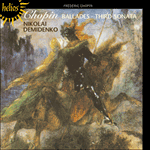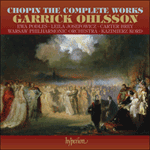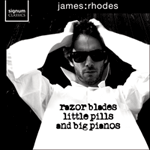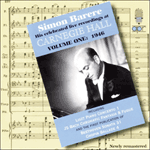Together with the Barcarolle, the Polonaise-Fantaisie, and the second and third sonatas, the Fourth Ballade represents the summit of Chopin’s art. The tentative start is haunting and suggestive and was once beautifully described by the critic Joan Chissell as bringing the same sense of wonder that a blind person, if granted the gift of sight, might feel on discovering the world’s beauty for the first time. The principal, highly Slavonic theme is closely related to the first of Chopin’s Trois Nouvelles Études (1839), the second of the opus 25 Études and surely provided an inspiration for Liszt’s La Leggierezza (1848; all four works are in the key of F minor). It returns twice bejewelled, and the second subject’s appearance in B flat and the return of the opening in A flat never disrupt the music’s self-generating momentum. An aerial cadenza and a canonic treatment of the first subject bear eloquent witness to Chopin’s increasing veneration for Bach, and the build-up and the pianissimo chords announcing a coda of the most fiery intricacy are as remarkable as anything in Chopin. They remind us simultaneously of his capacity for large-scale heroics and for the most intimate and hauntingly distinctive confidences.
from notes by Bryce Morrison © 2004
Avec la Barcarolle, la Polonaise-Fantaisie, et les deuxième et troisième Sonates, la Quatrième Ballade représente l’apogée de l’art de Chopin. Lancinant, suggestif, le début a été décrit par le critique Joan Chissell comme apportant un émerveillement comparable à celui qu’éprouverait un aveugle s’il pouvait voir et découvrir pour la première fois la beauté du monde. Le thème principal hautement slave est étroitement apparenté à la première des Trois Nouvelles Études (1839) de Chopin, la seconde des Études opus 25 et servit certainement d’inspiration à Liszt pour La Leggierezza (1848, ces quatre œuvres étant dans la même tonalité, fa mineur). Il revient à deux reprises, orné. L’apparition du second thème en si bémol majeur, ou la reprise du début en la bémol majeur ne parviennent jamais à perturber l’élan généré par la musique. Une cadence diaphane et un traitement en canon du premier thème témoignent avec éloquence de la vénération croissante que Chopin portait à Bach. La préparation et les accords pianissimo annonçant une coda d’une complexité des plus brûlantes sont tout autant remarquables. Ils rappellent cette capacité à exploiter simultanément les vastes pages épiques et les confidences les plus intimes, lancinantes et distinctives.
extrait des notes rédigées par Bryce Morrison © 2004
Français: Isabelle Battioni
Zusammen mit der Barcarolle, der Polonaise-Fantaisie und der zweiten und dritten Sonate stellt die Vierte Ballade den Höhepunkt von Chopins Oeuvre dar. Der vorsichtige Anfang ist eindringlich und bewegend und ist einmal von der Kritikerin Joan Chissell wunderschön beschrieben worden: er rief ein Gefühl hervor, dass so ähnlich sein müsse wie das, was ein Blinder spüren würde, dem das Augenlicht zurückgegeben würde und der zum ersten Mal die Schönheit der Welt für sich entdeckte. Das slawische Hauptthema erinnert sehr stark an sowohl die erste von Chopins Trois Nouvelles Études (1839) als auch die zweite Étude seines op. 25 und dient sicher auch als Inspirationsquelle für Liszts La Leggierezza (1848; alle vier Werke stehen in f-Moll). Es kehrt zweimal ausgeschmückt wieder und weder das Auftreten des zweiten Themas in B-Dur noch die Rückkehr des Anfangsmotivs in As-Dur wirkt sich hemmend auf die Eigendynamik der Musik aus. Eine luftige Kadenz und die kanonische Behandlung des ersten Themas bezeugt sehr gut Chopins zunehmende Verehrung für Bach, und die Steigerung der Musik und auch die Akkorde im Pianissimo, die die Coda mit einer feurigen Komplexität einleiten, gehören zu dem Bemerkenswertesten in Chopins Musik. Sie beweisen dem Hörer, dass er große Werke zu meistern verstand und gleichzeitig sehr Intimes und Charakteristisches vermitteln konnte.
aus dem Begleittext von Bryce Morrison © 2004
Deutsch: Viola Scheffel


 Chopin: Ballades & Sonata No 3
Chopin: Ballades & Sonata No 3 Chopin: The Complete Works
Chopin: The Complete Works Razor blades, little pills and big pianos
Razor blades, little pills and big pianos Simon Barere – His celebrated live recordings at Carnegie Hall, Vol. 1 - 1946
Simon Barere – His celebrated live recordings at Carnegie Hall, Vol. 1 - 1946
